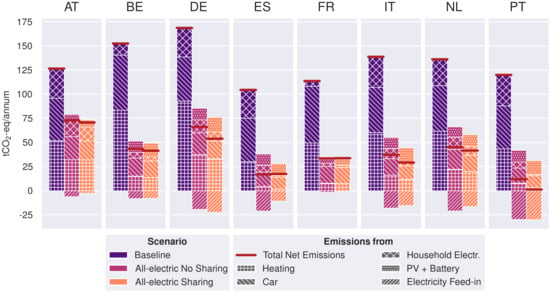Comparison of the Greenhouse Gas Emission Reduction Potential of Energy Communities
Abstract
:1. Introduction
2. Materials and Methods
2.1. Goal and Scope
2.2. Hourly Emissions Factors
2.3. GHG Emissions of Applied Technologies
2.3.1. Manufacturing of PV and BESS
2.3.2. Manufacturing of ICEVs and BEVs
2.3.3. GHG Emissions Related to Heat Supply
2.4. Community-Level GHG Emissions
- Electricity consumption from the grid
- Fuel combustion in ICEVs in the baseline scenario
- Fuel combustion for heating in the baseline scenario
- Manufacturing of vehicles, PV and battery systems, and heating technologies
- Electricity feed-in to the grid from PV (avoided or “negative” emissions)
2.5. Input Data
3. Results
3.1. Hourly Emission Factors
3.2. GHG Emissions of European Communities
3.2.1. Baseline Scenario
3.2.2. All-Electric Scenarios
3.2.3. Benefits of Community Energy-Sharing
3.3. Normalized GHG Emission Reduction Potentials
3.3.1. Transition from ICEVs to BEVs
3.3.2. Transition from Fossil Fuel Heat to Heat Pumps
3.3.3. Transition from Grid Consumption to PV Generation
3.3.4. Application of Batteries for Enhanced Self-Consumption of PV Electricity
3.4. Difference between AEF and HEF in Determining GHG Emissions
4. Conclusions and Discussion
Supplementary Materials
Author Contributions
Funding
Acknowledgments
Conflicts of Interest
Abbreviations
| Nomenclature | |
| AEF | Average Emission Factor |
| BESS | Battery Energy Storage Systems |
| BEV | Battery Electric Vehicle |
| DSM | Demand Side Management |
| EF | Emission Factor |
| GHG | Greenhouse Gas |
| HEF | Hourly Emission Factor |
| HP | Heat Pump |
| ICEV | Internal Combustion Engine Vehicle |
| LCA | Life-Cycle Assessment |
| LCI | Life-Cycle Inventory |
| PHEV | Plugin Hybrid Electric Vehicle |
| PV | Photovoltaics |
| RES | Renewable Energy Sources |
| TSO | Transmission System Operator |
| Indices | |
| j | Country |
| k | Generator type |
| l | Country imported from |
| t | Hour |
| Variables | |
| Electricity flow from grid to consumer | |
| Electricity flow from PV system to grid | |
| Emission factor for car transport in gCO-eq passengerkm | |
| Emission factor for heat supply in gCO-eq MJ | |
| Green House Gas emissions of electricity consumption | |
| Green House Gas emissions of electricity generation | |
| Green House Gas emissions of electricity on high-voltage lines | |
| Hourly Emission Factor of electricity consumption | |
| Hourly Emission Factor of electricity generation | |
| Hourly Emission Factor of electricity on high-voltage lines |
Appendix A. Explanation for Treatment of Missing Data
Appendix A.1. Explanation for Treatment of “Other” Categories
| Country | Other (% of Total Generation) | Other Renewable (% of Total Generation) | Correlation with ENTSO-E Power Stats |
|---|---|---|---|
| Belgium | 6.2 | N.A. | 0.950 |
| France | N.A. | N.A. | 0.988 |
| Germany and Austria | 6.8 | 0.3 | 0.981 |
| Italy | 31.5 | 0.0 | 0.973 |
| Netherlands | N.A. | N.A. | 0.548 |
| Portugal | 0.6 | N.A. | 0.941 |
| Spain | 0.2 | 0.3 | 0.950 |
Appendix A.2. Explanation for Allocation of Missing Data in Italy
Appendix A.2.1. Biomass
Appendix A.2.2. Coal
- Assume coal provides baseload power, take a fixed load factor and calibrate the load factor to be in line with the total of coal as reported by Terna.
- Multiply the available data by a factor which is calibrated to be in line with the total of coal as reported by Terna.
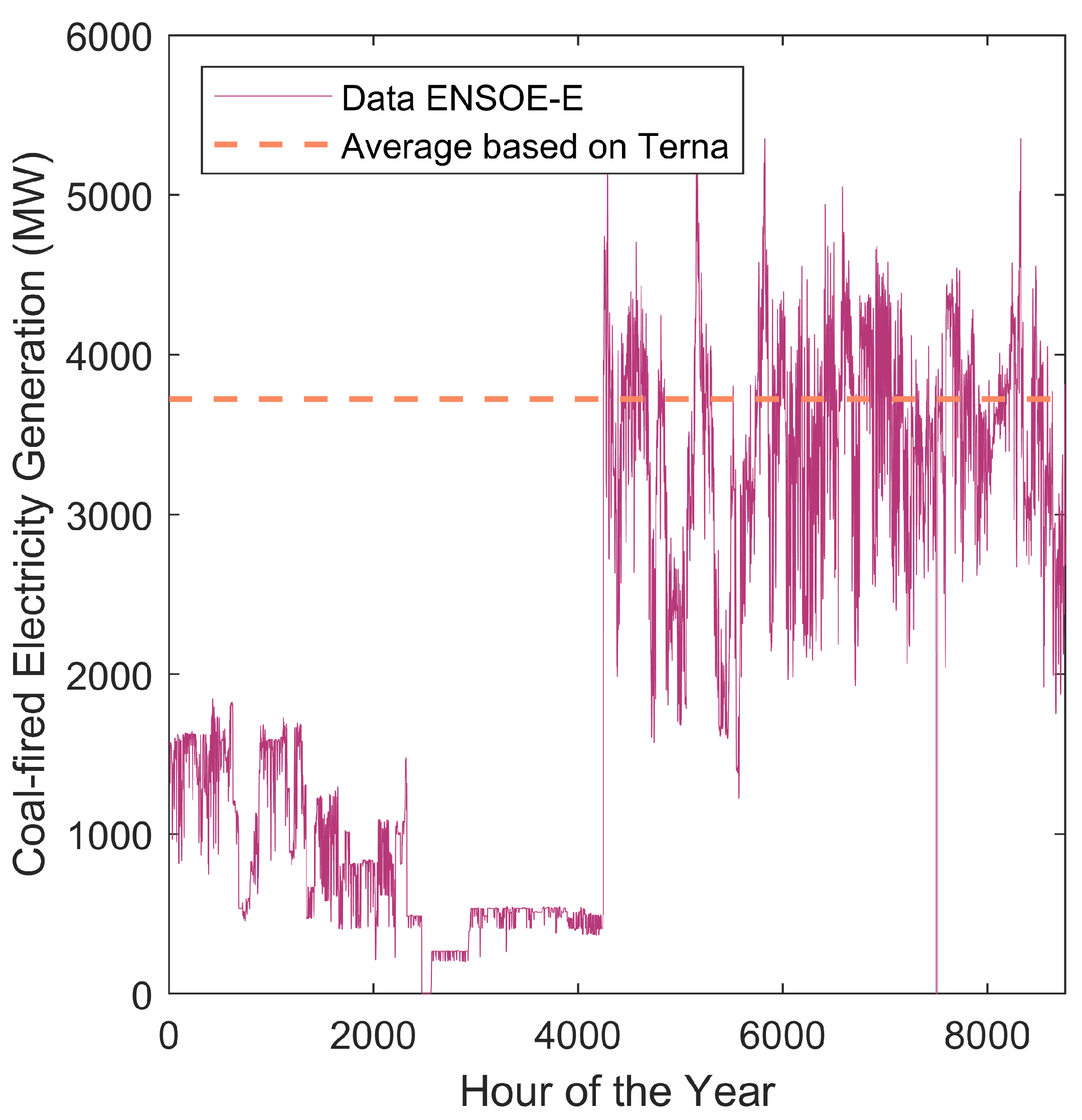
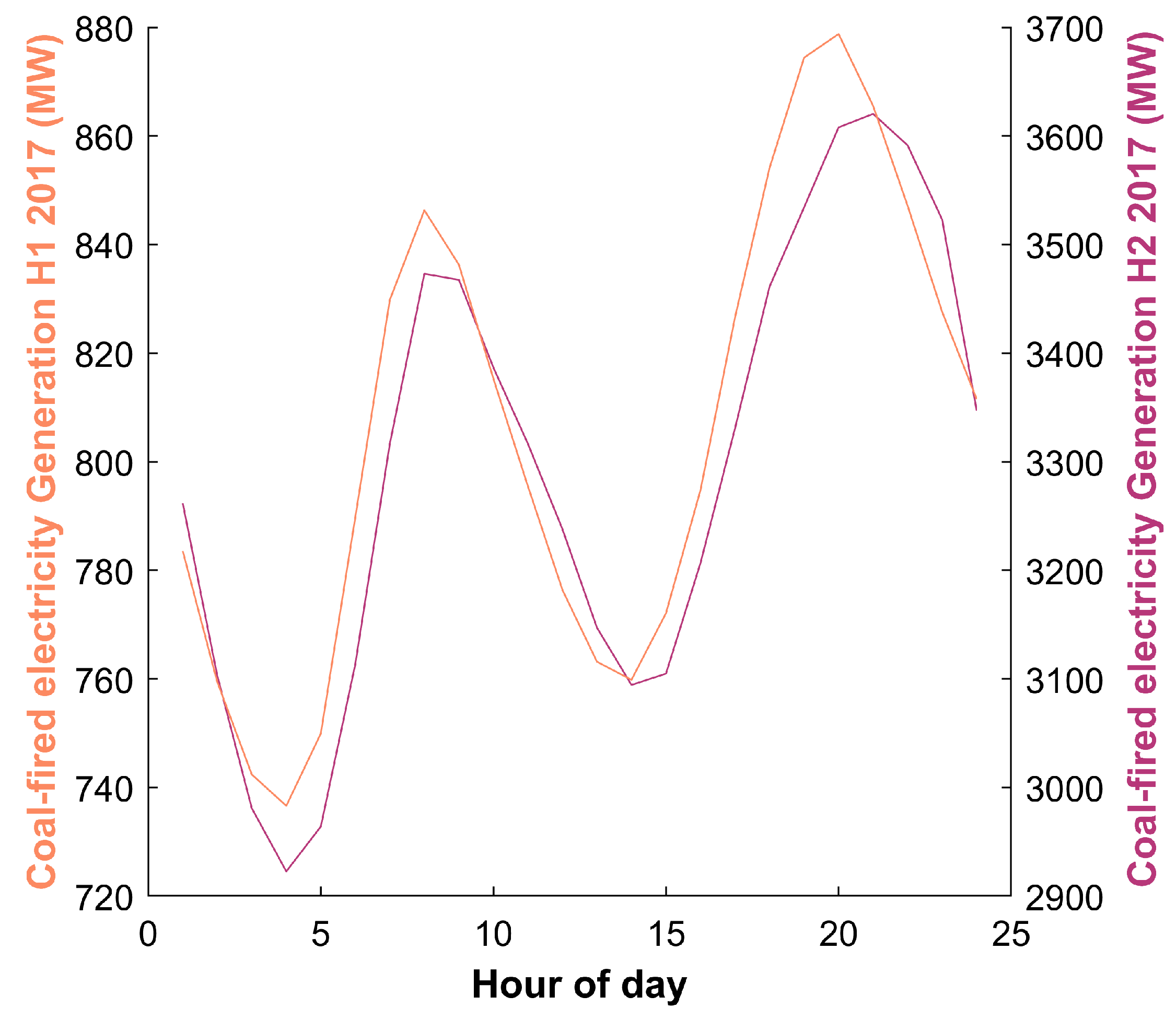
Appendix A.2.3. Fossil Oil and Fossil Gas
Appendix A.3. Explanation Missing Data The Netherlands
References
- European Commission. Regulation of the European Parliament and of the Council on the Internal Market for Electricity; European Union: Brussels, Belgium, 2016. [Google Scholar]
- European Commission. Electrification of the Transport System: Studies and Reports; Technical Report; European Union: Brussels, Belgium, 2017; Available online: http://ec.europa.eu/newsroom/horizon2020/document.cfm?doc_id=46372 (accessed on 6 November 2019).
- IEA. Perspectives for the Clean Energy Transition; Technical Report; IEA: Paris, France, 2019. [Google Scholar]
- IEA. World Energy Outlook 2018; Technical Report; IEA: Paris, France, 2018. [Google Scholar]
- Schmela, M.; Beauvais, A.; Chevillard, N.; Paredes, M.G.; Heisz, M.; Rossi, R.; China Photovoltaic Industry Association (CPIA); Whitten, D.; US Solar Energy Industries Association. Global Market Outlook: 2019–2023; Technical Report; SolarPower Europe: Brussels, Belgium, 2019. [Google Scholar]
- Kubli, M.; Loock, M.; Wüstenhagen, R. The flexible prosumer: Measuring the willingness to co-create distributed flexibility. Energy Policy 2018, 114, 540–548. [Google Scholar] [CrossRef]
- Fischer, D.; Madani, H. On heat pumps in smart grids: A review. Renew. Sustain. Energy Rev. 2017, 70, 342–357. [Google Scholar] [CrossRef]
- Litjens, G.; Worrell, E.; van Sark, W. Lowering greenhouse gas emissions in the built environment by combining ground source heat pumps, photovoltaics and battery storage. Energy Build. 2018, 180, 51–71. [Google Scholar] [CrossRef]
- Staffell, I.; Pfenninger, S. The increasing impact of weather on electricity supply and demand. Energy 2018, 145, 65–78. [Google Scholar] [CrossRef]
- Eggimann, S.; Hall, J.W.; Eyre, N. A high-resolution spatio-temporal energy demand simulation to explore the potential of heating demand side management with large-scale heat pump diffusion. Appl. Energy 2019, 236, 997–1010. [Google Scholar] [CrossRef]
- Mwasilu, F.; Justo, J.J.; Kim, E.K.; Do, T.D.; Jung, J.W. Electric vehicles and smart grid interaction: A review on vehicle to grid and renewable energy sources integration. Renew. Sustain. Energy Rev. 2014, 34, 501–516. [Google Scholar] [CrossRef]
- Sundström, O.; Binding, C. Flexible charging optimization for electric vehicles considering distribution grid constraints. IEEE Trans. Smart Grid 2012, 3, 26–37. [Google Scholar] [CrossRef]
- Yong, J.Y.; Ramachandaramurthy, V.K.; Tan, K.M.; Mithulananthan, N. A review on the state-of-the-art technologies of electric vehicle, its impacts and prospects. Renew. Sustain. Energy Rev. 2015, 49, 365–385. [Google Scholar] [CrossRef]
- Schram, W.L.; Lampropoulos, I.; van Sark, W.G.J.H.M. Photovoltaic systems coupled with batteries that are optimally sized for household self-consumption: Assessment of peak shaving potential. Appl. Energy 2018, 223, 69–81. [Google Scholar] [CrossRef]
- Katsanevakis, M.; Stewart, R.A.; Lu, J. Aggregated applications and benefits of energy storage systems with application-specific control methods: A review. Renew. Sustain. Energy Rev. 2017, 75, 719–741. [Google Scholar] [CrossRef]
- Lampropoulos, I.; Alskaif, T.; Blom, J.; van Sark, W. A framework for the provision of flexibility services at the transmission and distribution levels through aggregator companies. Sustain. Energy Grids Netw. 2019, 17, 100187. [Google Scholar] [CrossRef]
- Siano, P. Demand response and smart grids—A survey. Renew. Sustain. Energy Rev. 2014, 30, 461–478. [Google Scholar] [CrossRef]
- Dóci, G.; Vasileiadou, E. “Let’s do it ourselves” Individual motivations for investing in renewables at community level. Renew. Sustain. Energy Rev. 2015, 49, 41–50. [Google Scholar] [CrossRef]
- PVP4Grid. PV-Prosumers4Grid—Enabling Consumers to Become PV Prosumers in a System-Friendly Manner. 2019. Available online: https://www.pvp4grid.eu/ (accessed on 1 October 2019).
- Fleischhacker, A.; Radl, J.; Revheim, F.; Lettner, G.; Schwabeneder, D.; Auer, H. Quantitative Analyses of Improved PVP4Grid Concepts and Report on Testing; Technical Report; Deliverable D3.2 of the Project PVP4Grid; Technische Universitaet Wien: Vienna, Austria, 2019; Available online: http://www.pvp4grid.eu (accessed on 1 October 2019).
- Steg, L.; Vlek, C. Encouraging pro-environmental behaviour: An integrative review and research agenda. J. Environ. Psychol. 2009, 29, 309–317. [Google Scholar] [CrossRef]
- Lyons, L. Digitalisation: Opportunities for Heating and Cooling; Publications Office of the European Union: Luxembourg, 2019. [Google Scholar] [CrossRef]
- Lindmayer, J.; Anderson, J.; Clifford, A.; Lafky, W.; Scheinine, A.; Wihl, M.; Wrigley, C. Solar Breeder: Energy Payback Time for Silicon Photovoltaic Systems. Report No. SX/111/1Q; Technical Report; Solarex Corporation: Rockville, MD, USA, 1977. [Google Scholar]
- Wihl, M.; Scheinine, A. Analysis and simulation of the energy source of the future—The solar breeder. In Proceedings of the 13th Photovoltaics Specialists Conference, Washington, DC, USA, 5–8 June 1978; pp. 908–910. [Google Scholar]
- Bhandari, K.P.; Collier, J.M.; Ellingson, R.J.; Apul, D.S. Energy payback time (EPBT) and energy return on energy invested (EROI) of solar photovoltaic systems: A systematic review and meta-analysis. Renew. Sustain. Energy Rev. 2015, 47, 133–141. [Google Scholar] [CrossRef]
- Asdrubali, F.; Baldinelli, G.; D’Alessandro, F.; Scrucca, F. Life cycle assessment of electricity production from renewable energies: Review and results harmonization. Renew. Sustain. Energy Rev. 2015. [Google Scholar] [CrossRef]
- Pehl, M.; Arvesen, A.; Humpenöder, F.; Popp, A.; Hertwich, E.G.; Luderer, G. Understanding future emissions from low-carbon power systems by integration of life-cycle assessment and integrated energy modelling. Nat. Energy 2017. [Google Scholar] [CrossRef]
- Abdul-Manan, A.F. Uncertainty and differences in GHG emissions between electric and conventional gasoline vehicles with implications for transport policy making. Energy Policy 2015. [Google Scholar] [CrossRef]
- Bauer, C.; Hofer, J.; Althaus, H.J.; Del Duce, A.; Simons, A. The environmental performance of current and future passenger vehicles: Life Cycle Assessment based on a novel scenario analysis framework. Appl. Energy 2015. [Google Scholar] [CrossRef]
- Cerdas, F.; Egede, P.; Herrmann, C. LCA of Electromobility. In Life Cycle Assessment; Springer International Publishing: Cham, Switzerland, 2018; pp. 669–693. [Google Scholar] [CrossRef]
- Höltl, A.; Macharis, C.; De Brucker, K. Pathways to Decarbonise the European Car Fleet: A Scenario Analysis Using the Backcasting Approach. Energies 2017, 11, 20. [Google Scholar] [CrossRef]
- Kawamoto, R.; Mochizuki, H.; Moriguchi, Y.; Nakano, T.; Motohashi, M.; Sakai, Y.; Inaba, A. Estimation of CO2 Emissions of Internal Combustion Engine Vehicle and Battery Electric Vehicle Using LCA. Sustainability 2019, 11, 2690. [Google Scholar] [CrossRef]
- Moro, A.; Lonza, L. Electricity carbon intensity in European Member States: Impacts on GHG emissions of electric vehicles. Transp. Res. Part D Transp. Environ. 2018. [Google Scholar] [CrossRef] [PubMed]
- Onat, N.C.; Noori, M.; Kucukvar, M.; Zhao, Y.; Tatari, O.; Chester, M. Exploring the suitability of electric vehicles in the United States. Energy 2017, 121, 631–642. [Google Scholar] [CrossRef]
- Wu, Z.; Wang, M.; Zheng, J.; Sun, X.; Zhao, M.; Wang, X. Life cycle greenhouse gas emission reduction potential of battery electric vehicle. J. Clean. Prod. 2018. [Google Scholar] [CrossRef]
- Abusoglu, A.; Sedeeq, M.S. Comparative exergoenvironmental analysis and assessment of various residential heating systems. Energy Build. 2013, 62, 268–277. [Google Scholar] [CrossRef]
- Blom, I.; Itard, L.; Meijer, A. LCA-based environmental assessment of the use and maintenance of heating and ventilation systems in Dutch dwellings. Build. Environ. 2010, 45, 2362–2372. [Google Scholar] [CrossRef]
- Genkinger, A.; Dott, R.; Afjei, T. Combining Heat Pumps with Solar Energy for Domestic Hot Water Production. Energy Procedia 2012, 30, 101–105. [Google Scholar] [CrossRef]
- Greening, B.; Azapagic, A. Domestic heat pumps: Life cycle environmental impacts and potential implications for the UK. Energy 2012, 39, 205–217. [Google Scholar] [CrossRef]
- Koroneos, C.J.; Nanaki, E.A. Environmental impact assessment of a ground source heat pump system in Greece. Geothermics 2017, 65, 1–9. [Google Scholar] [CrossRef]
- Nitkiewicz, A.; Sekret, R. Comparison of LCA results of low temperature heat plant using electric heat pump, absorption heat pump and gas-fired boiler. Energy Convers. Manag. 2014, 87, 647–652. [Google Scholar] [CrossRef]
- Ozdogan Dolcek, A.; Tinjum, J.M. Life-cycle assessment of various types of residential ground-coupled heat pump systems: Wisconsin, US case. Sol. Energy 2019. [Google Scholar] [CrossRef]
- Shah, V.P.; Debella, D.C.; Ries, R.J. Life cycle assessment of residential heating and cooling systems in four regions in the United States. Energy Build. 2008, 40, 503–513. [Google Scholar] [CrossRef]
- Pellow, M.A.; Ambrose, H.; Mulvaney, D.; Betita, R.; Shaw, S. Research gaps in environmental life cycle assessments of lithium ion batteries for grid-scale stationary energy storage systems: End-of-life options and other issues. Sustain. Mater. Technol. 2019, e00120. [Google Scholar] [CrossRef]
- Lausselet, C.; Borgnes, V.; Brattebø, H. LCA modelling for Zero Emission Neighbourhoods in early stage planning. Build. Environ. 2019, 149, 379–389. [Google Scholar] [CrossRef]
- Lund, K.M.; Lausselet, C.; Brattebø, H. LCA of the Zero Emission Neighbourhood Ydalir. IOP Conf. Ser. Earth Environ. Sci. 2019, 352. [Google Scholar] [CrossRef]
- Smith, C.; Burrows, J.; Scheier, E.; Young, A.; Smith, J.; Young, T.; Gheewala, S.H. Comparative Life Cycle Assessment of a Thai Island’s diesel/PV/wind hybrid microgrid. Renew. Energy 2015, 80, 85–100. [Google Scholar] [CrossRef]
- Schram, W.; Lampropoulos, I.; Alskaif, T.; Sark, W.V. On the Use of Average versus Marginal Emission Factors. In Proceedings of the 8th International Conference on Smart Cities and Green ICT Systems (SMARTGREENS 2019), Heraklion, Crete, Greece, 3–5 May 2019; SciTePress: Heraklion, Crete, Greece, 2019; pp. 187–193. [Google Scholar]
- Ryan, N.A.; Lin, Y.; Mitchell-Ward, N.; Mathieu, J.L.; Johnson, J.X. Use-Phase Drives Lithium-Ion Battery Life Cycle Environmental Impacts When Used for Frequency Regulation. Environ. Sci. Technol. 2018, 52, 10163–10174. [Google Scholar] [CrossRef]
- Fares, R.L.; Webber, M.E. The impacts of storing solar energy in the home to reduce reliance on the utility. Nat. Energy 2017, 2, 17001. [Google Scholar] [CrossRef]
- Bettle, R.; Pout, C.H.; Hitchin, E.R. Interactions between electricity-saving measures and carbon emissions from power generation in England and Wales. Energy Policy 2006, 34, 3434–3446. [Google Scholar] [CrossRef]
- Marnay, C.; Fisher, D.; Murtishaw, S.; Phadke, A.; Price, L.; Sathaye, J. Estimating Carbon Dioxide Emissions Factors for the California Electric Power Sector; Technical Report; Lawrence Berkeley National Laboratory: Berkeley, CA, USA, 2002.
- Thomson, R.C.; Harrison, G.P.; Chick, J.P. Marginal greenhouse gas emissions displacement of wind power in Great Britain. Energy Policy 2017, 101, 201–210. [Google Scholar] [CrossRef]
- Wernet, G.; Bauer, C.; Steubing, B.; Reinhard, J.; Moreno-Ruiz, E.; Weidema, B. The ecoinvent database version 3 (part I): Overview and methodology. Int. J. Life Cycle Assess. 2016, 21, 1218–1230. [Google Scholar] [CrossRef]
- ENTSO-E. Actual Generation per Production Type. 2019. Available online: https://transparency.entsoe.eu/generation/r2/actualGenerationPerProductionType/show (accessed on 10 July 2019).
- Eurostat. Passenger Cars, by Type of Motor Energy. 2019. Available online: https://ec.europa.eu/eurostat/data/database (accessed on 1 September 2019).
- Fleiter, T.; Elsland, R.; Rehfeldt, M.; Steinbach, J.; Reiter, U.; Catenazzi, G.; Jakob, M.; Rutten, C.; Harmsen, R.; Dittmann, F.; et al. Profile of Heating and Cooling Demand in 2015. Technical Report; Deliverable D3.1 of the Project Heat Roadmap Europe. 2017. Available online: https://heatroadmap.eu (accessed on 1 September 2019).
- ENTSO-E. Monthly Hourly Load Values. 2019. Available online: https://www.entsoe.eu/data/power-stats/hourly_load/ (accessed on 10 July 2019).
- Harmsen, R.; Graus, W. How much CO2 emissions do we reduce by saving electricity? A focus on methods. Energy Policy 2013, 60, 803–812. [Google Scholar] [CrossRef]
- Terna. The Evolution of the Electricity Market: All Da. 2019. Available online: https://www.terna.it/en/electric-system/statistical-data-forecast/evolution-electricity-market (accessed on 10 July 2019).
- CBS. Elektriciteit en Warmte Productie en inzet naar Energiedrager. 2019. Available online: https://opendata.cbs.nl/statline/CBS/nl/dataset/80030NED (accessed on 10 July 2019).
- ENTSO-E. Specific National Considerations; Technical Report; ENTSO-E, Brussels, Belgium: 2016. Available online: https://docstore.entsoe.eu/Documents/Publications/Statistics/Specific_national_considerations.pdf (accessed on 10 July 2019).
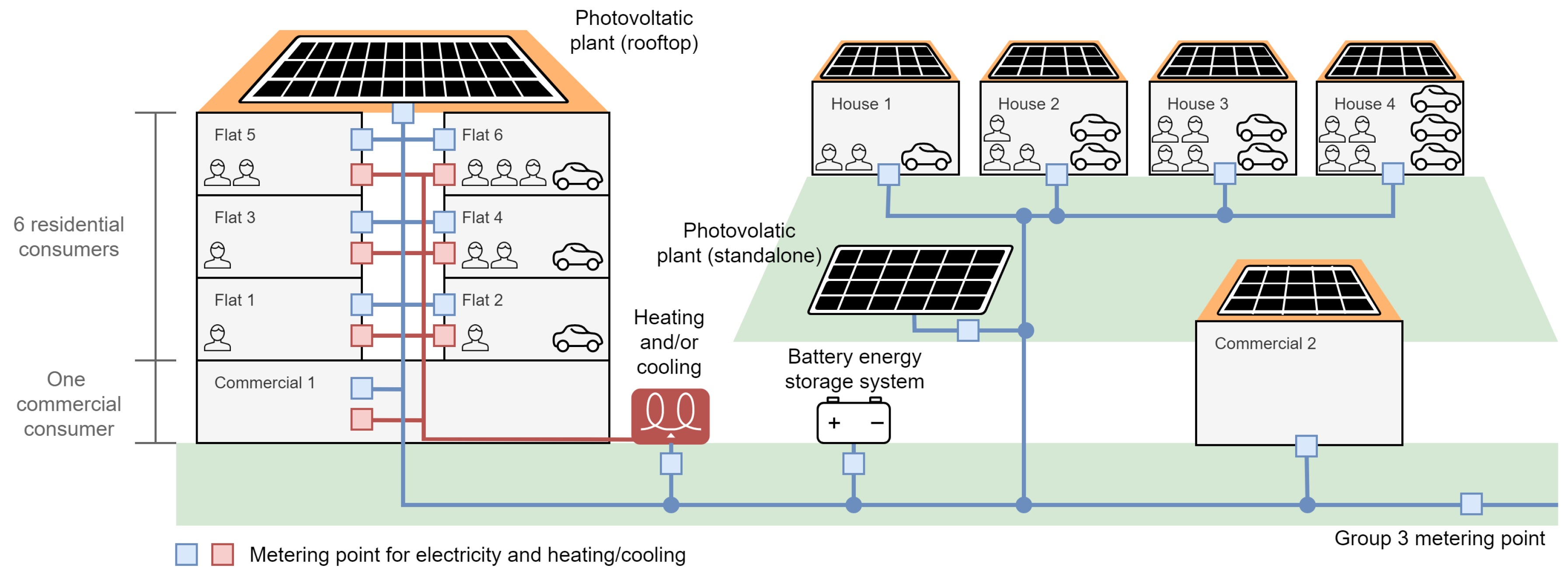

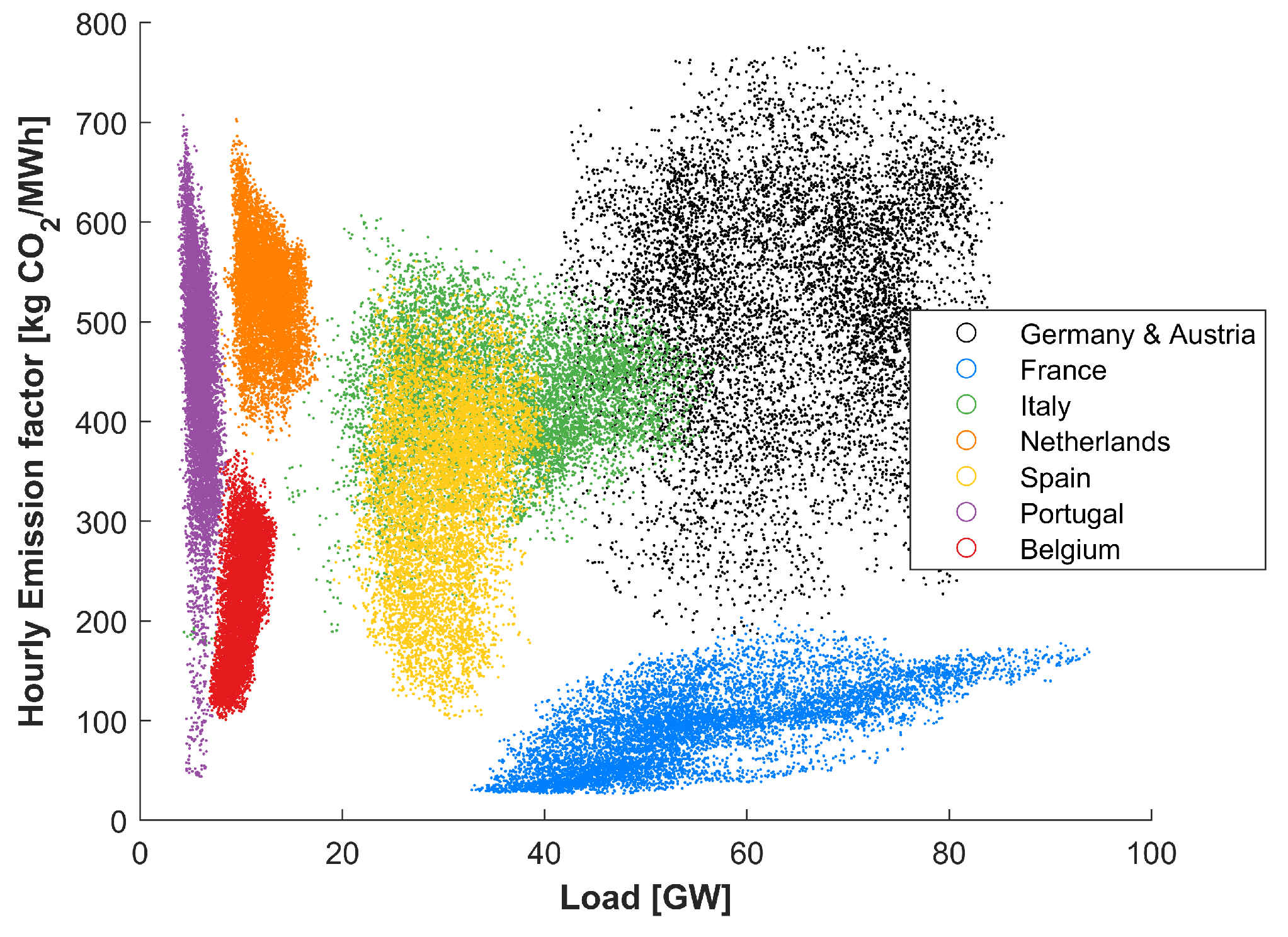
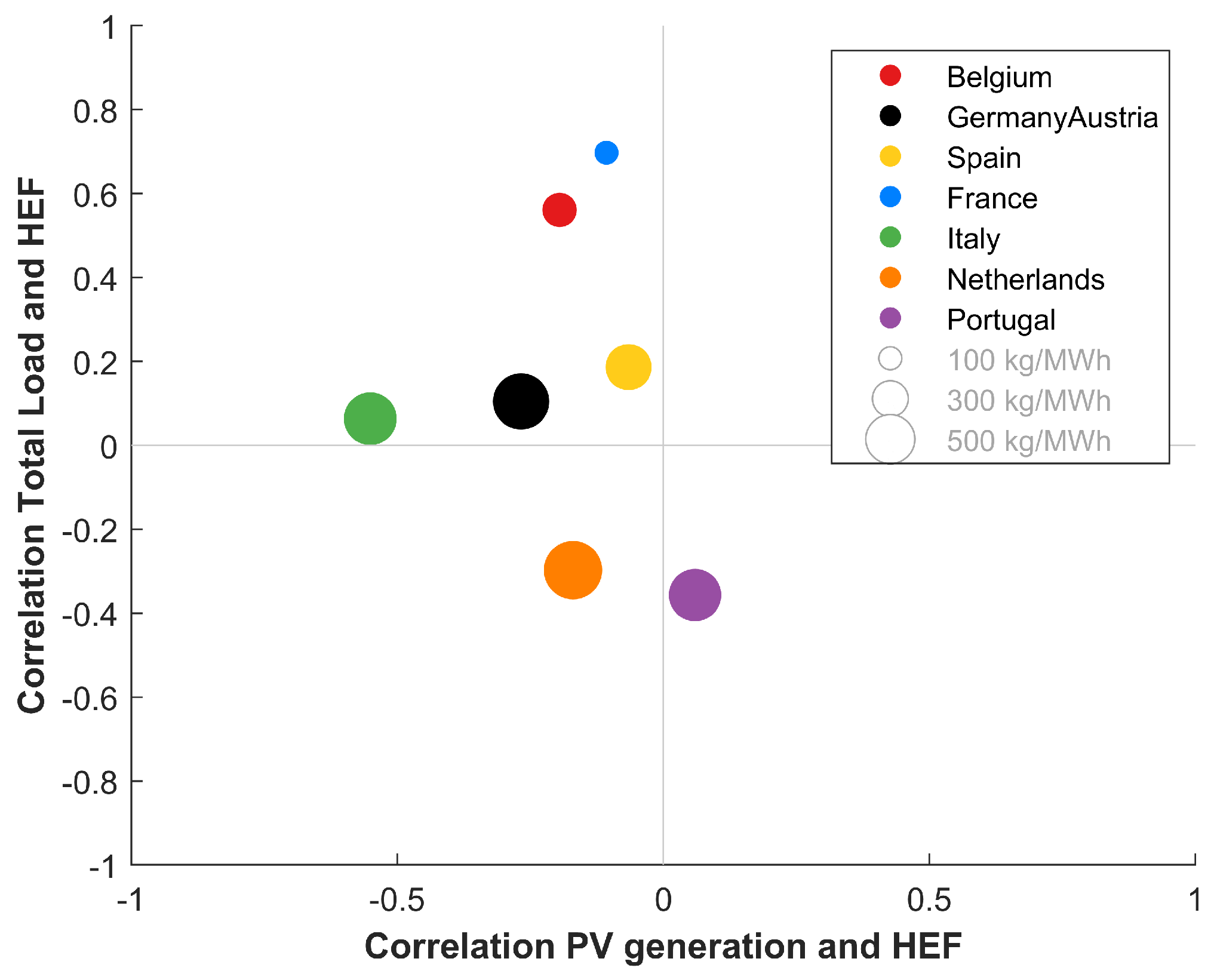
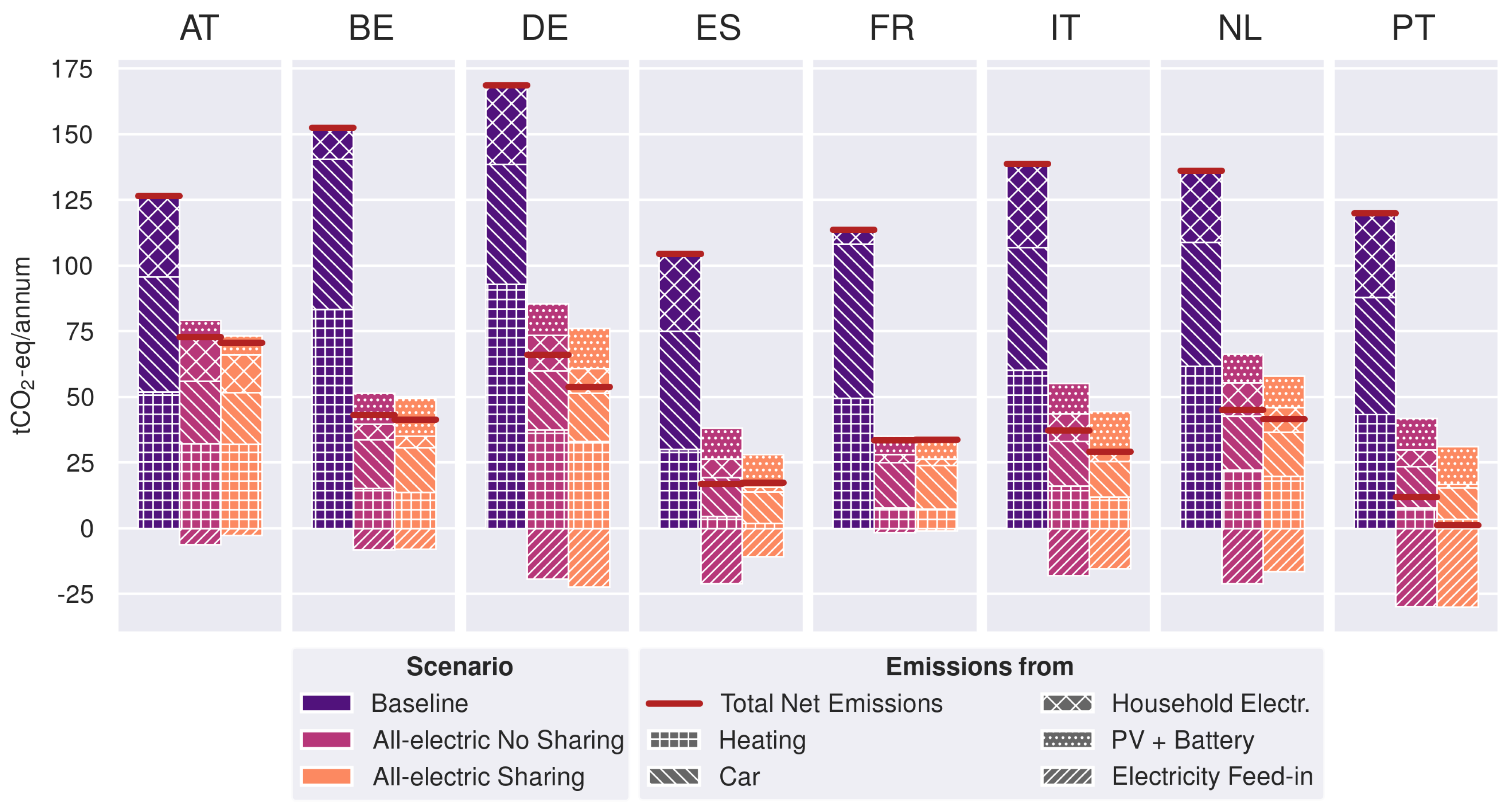
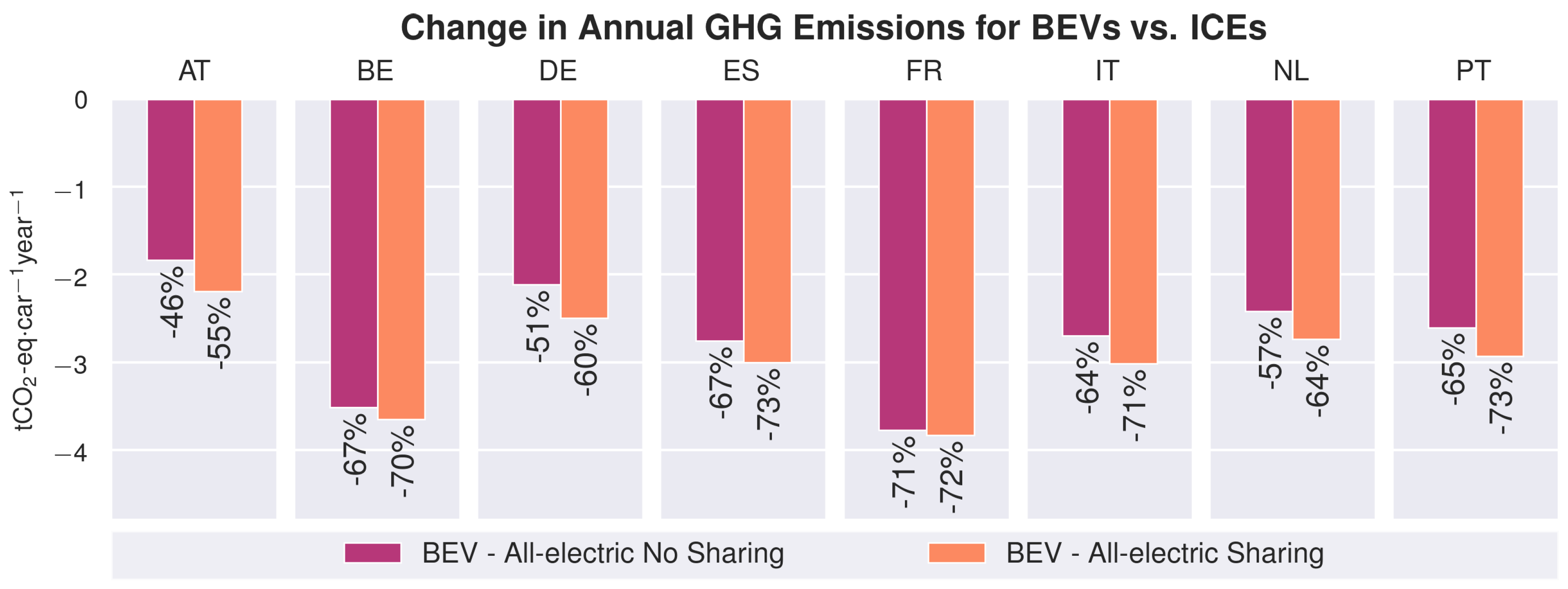
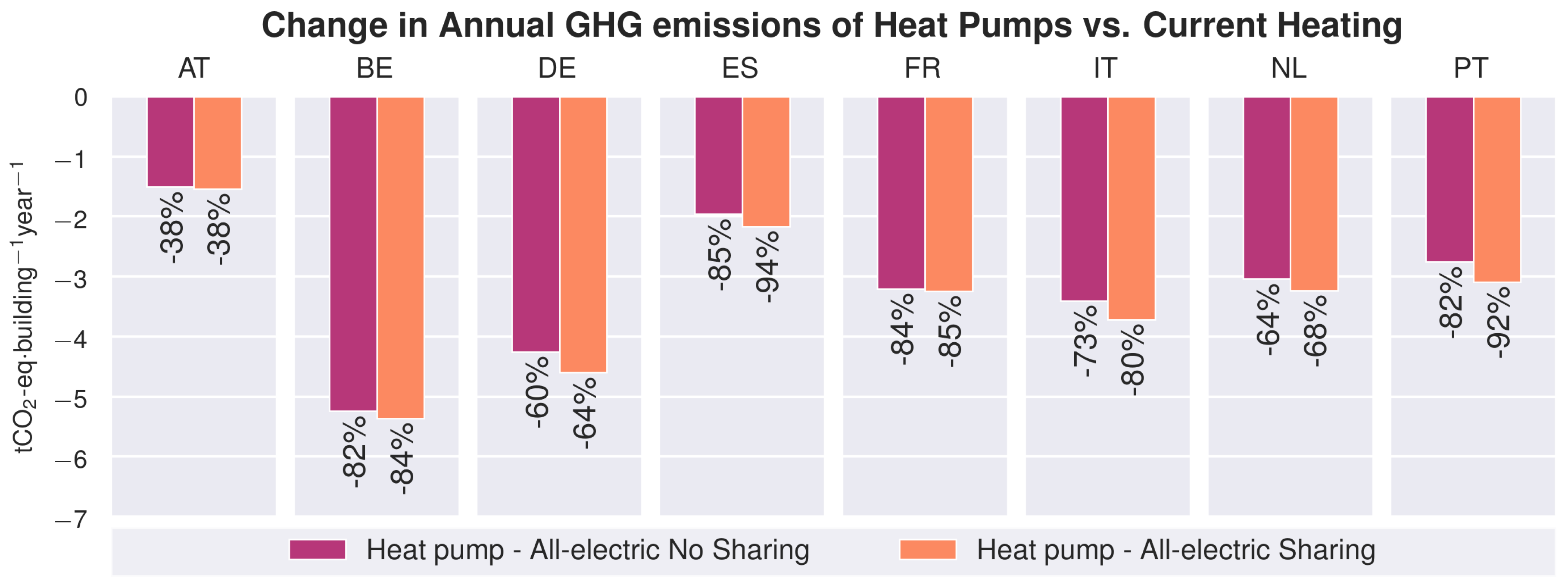
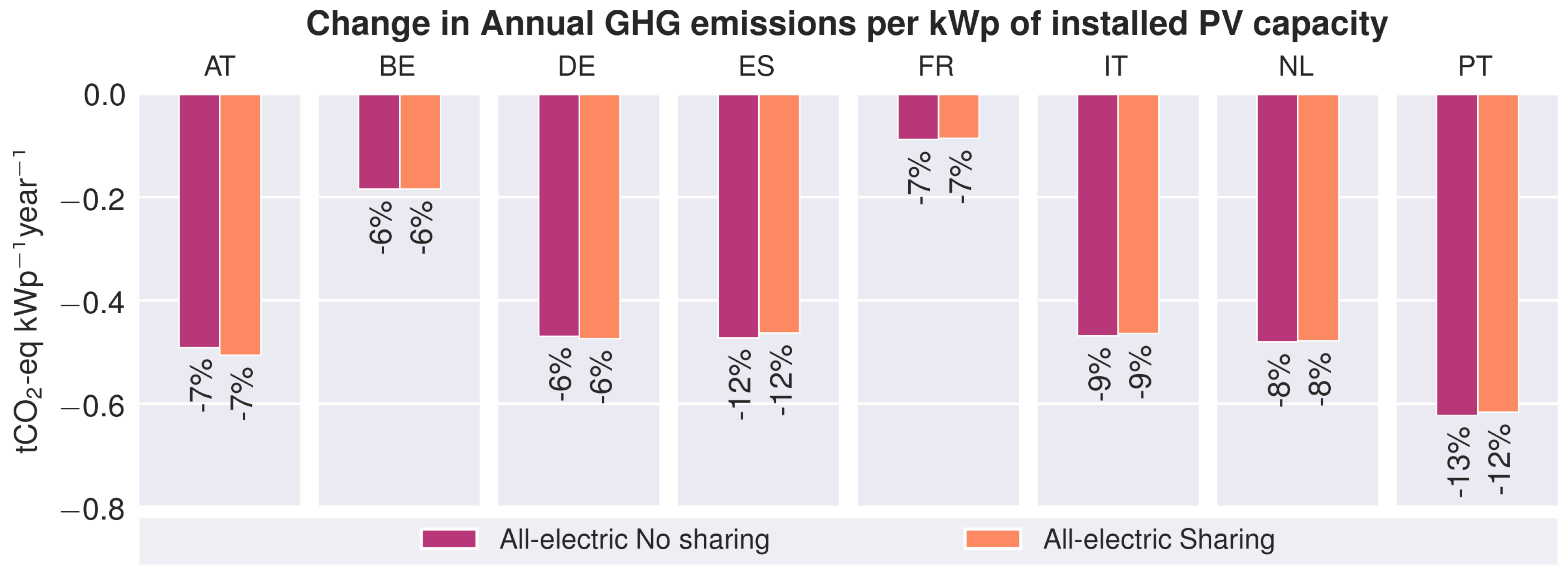

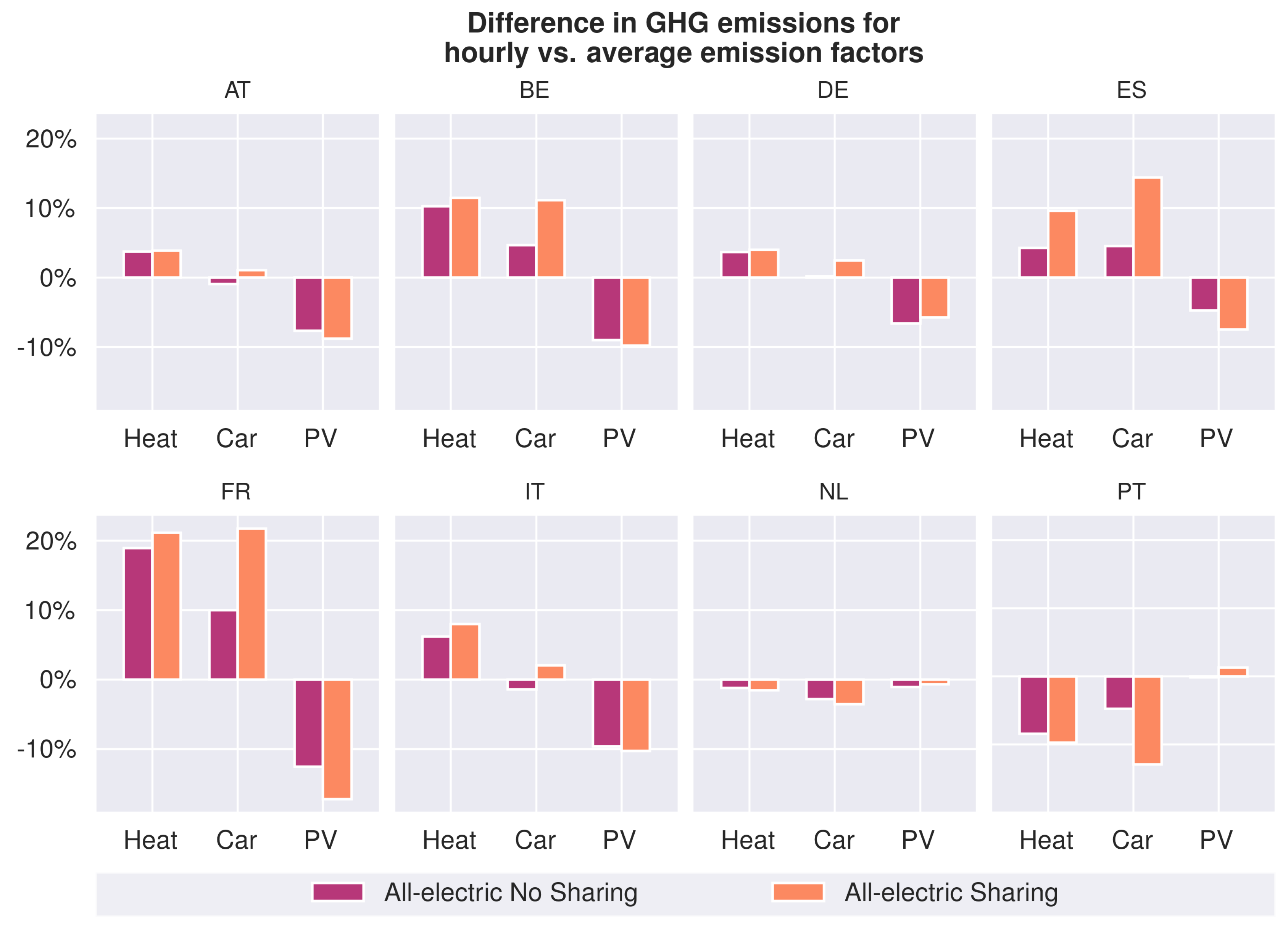
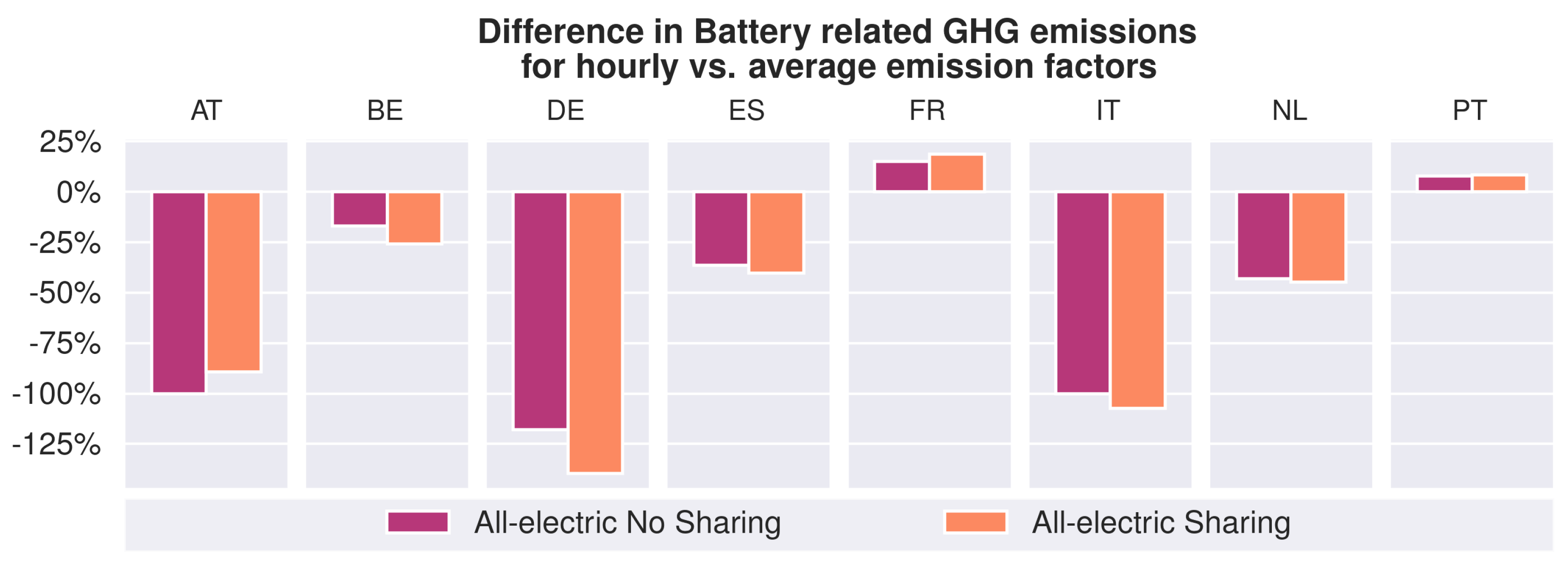
| Country | Installed PV Capacity No Energy Sharing (kW) | Installed PV Capacity Energy sharing (kW) | Installed Battery Capacity No Energy Sharing (kWh) | Installed Battery Capacity Energy Sharing (kWh) |
|---|---|---|---|---|
| Austria | 71.8 | 74.5 | 10.9 | 12.8 |
| Belgium | 121.7 | 146.7 | 19.5 | 30.6 |
| France | 72.9 | 86.6 | 5.6 | 15.6 |
| Germany | 123.5 | 155.8 | 22.4 | 34.9 |
| Italy | 121.9 | 146.7 | 18.9 | 31.4 |
| Netherlands | 113.9 | 124.6 | 16.4 | 24.3 |
| Portugal | 123.7 | 146.7 | 23.5 | 37.1 |
| Spain | 120.8 | 124.6 | 25.0 | 36.5 |
© 2019 by the authors. Licensee MDPI, Basel, Switzerland. This article is an open access article distributed under the terms and conditions of the Creative Commons Attribution (CC BY) license (http://creativecommons.org/licenses/by/4.0/).
Share and Cite
Schram, W.; Louwen, A.; Lampropoulos, I.; van Sark, W. Comparison of the Greenhouse Gas Emission Reduction Potential of Energy Communities. Energies 2019, 12, 4440. https://doi.org/10.3390/en12234440
Schram W, Louwen A, Lampropoulos I, van Sark W. Comparison of the Greenhouse Gas Emission Reduction Potential of Energy Communities. Energies. 2019; 12(23):4440. https://doi.org/10.3390/en12234440
Chicago/Turabian StyleSchram, Wouter, Atse Louwen, Ioannis Lampropoulos, and Wilfried van Sark. 2019. "Comparison of the Greenhouse Gas Emission Reduction Potential of Energy Communities" Energies 12, no. 23: 4440. https://doi.org/10.3390/en12234440
APA StyleSchram, W., Louwen, A., Lampropoulos, I., & van Sark, W. (2019). Comparison of the Greenhouse Gas Emission Reduction Potential of Energy Communities. Energies, 12(23), 4440. https://doi.org/10.3390/en12234440






